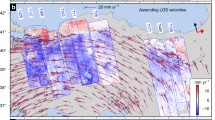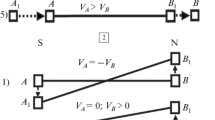Summary
Local variations in the geomagnetic field, which are produced by stress changes in crustal rocks, are calculable from the stress patterns and the piezomagnetic properties of the rocks down to the Curie point isotherm. Release of stress during movement along a section of a transcurrent fault at an angle ϕ, measured clockwise with respect to the direction of magnetization of the rocks, produces a change in field similar to that which would be produced by the addition of a buried dipole of orientation (2ϕ±π/2), the alternative signs applying to right- and left-lateral faults. Computed seismomagnetic anomalies of horizontal, vertical and total field are plotted for different fault orientations in simple geological environments. Time-dependent magnetic anomalies with magnitudes of the order 10 gammas may commonly accompany the build-up of stress before an earthquake and provide a pre-indication of it.
Similar content being viewed by others
References
A. G. Kalashnikov,The possible application of magnetometric methods to the question of earthquake indications, Akad. Nauk. S.S.S.R., Geofiz. Inst. Trudy No.25 (1954), 162.
F. D. Stacey,A note on the possibility of forecasting earthquakes from geomagnetic measurements, Geomagnetica (Serviço Meteorol. Nacional, Lisbon 1962), 109.
F. D. Stacey,The seismomagnetic effect and the possibility of earthquake forecasting, Nature200 (1963), 1083.
K. Sassa andE. Nishimura,On phenomena forerunning earthquakes, Disaster Prevention Res. Inst. Kyoto, Bulletin 13 (1956).
Y. Kato,Investigation of the changes in the earth's magnetic field accompanying earthquakes or volcanic eruptions, Tohoku Univ. Sci. Rep., Series 1,27 (1938), 1.
Y. Kato andA. Takagi,Further note on the investigation of the changes in the earth's magnetic field accompanying earthquake or volcanic eruption, Sci. Reps. Tohoku Univ., Series 5, Geophysics5 (1953), 67.
J. P. Rothé,Déformations des anomalies magnétiques et séismes, Publ. Bureau Central Seismol. Internat., Serie A, Fasc. 17 (1950).
S. P. Kapitsa,Magnetic properties of eruptive rocks exposed to mechanical stresses, Akad. Nauk. S.S.S.R. Izv. Ser. Geofiz. No. 6 (1955), 489.
F. D. Stacey,Theory of the magnetic susceptibility of stressed rock, Phil. Mag.7 (1962), 551.
F. D. Stacey,The physical theory of rock magnetism, Advances in Physics12 (1963), 45.
B. Gutenberg,Magnitude and energy of earthquakes, Trans. Amer. Geophys. Un.41 (1960), 148.
E. C. Bullard, C. Freedman, H. Gellman andJ. Nixon,The westward drift of the earth's magnetic field, Phil. Trans. Roy. Soc., London, A 243 (1950), 67.
Author information
Authors and Affiliations
Rights and permissions
About this article
Cite this article
Stacey, F.D. The seismomagnetic effect. PAGEOPH 58, 5–22 (1964). https://doi.org/10.1007/BF00879136
Received:
Issue Date:
DOI: https://doi.org/10.1007/BF00879136




